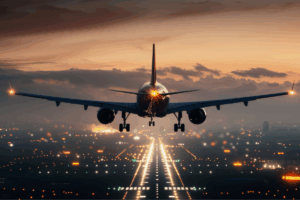Airport lighting technology has come a long way since early 20th-century innovators placed incandescent lights along runways to help guide pilots during takeoff and landing. With the rise of LED lighting and integrated control systems, the sky has proven to be the limit when it comes to technology that manages inbound and outbound air traffic.
In recent years, “smart”/” intelligent” systems have become a part of many people’s daily lives, helping them automate everything from home lighting to kitchen appliances. Many businesses also depend on intelligent systems to run their HVAC systems, monitor energy usage, and predict maintenance.
It was only a matter of time until smart lighting technology would make its way into airport runway lighting systems – and that time is now.
How Does Smart Lighting Help Airport Lighting Systems?
Smart lighting systems use sensors, real-time data analytics, and live control mechanisms to create an adaptive and dynamic system that can adjust lights based on several factors, including aircraft location monitoring and weather conditions.
Here are some of the ways that intelligent lighting systems can optimize your airport operations:
Aircraft Location Monitoring
Advanced smart lighting systems have the ability to track aircraft movements on the runway and taxiways. The system will then activate the appropriate lights only when an aircraft is present. This dynamic lighting functionality reduces unnecessary light pollution and energy usage.
Read More: The Evolution Of Technology In Airport Runway Lighting
Adaptable To Weather Conditions
Smart lighting can adjust lighting levels in real-time based on data from weather monitoring stations, ensuring that runway visibility is maximized at all times. For example, during thick fog or heavy rain, the system will automatically increase the brightness of runway lights to help ensure a safe approach, landing, and taxiing.
Remote Monitoring And Control
With smart lighting, airport operators can monitor and control your entire lighting system remotely, allowing them to troubleshoot any potential issues proactively. If the system detects any lighting or power anomalies, remote operators can respond from any location to arrange for inspection and repair. Additionally, intelligent systems optimize maintenance by indicating precisely where the problem is, so your team won’t waste valuable time inspecting each lighting fixture.
Read More: The Critical Role Of Airport Lighting In Aviation Safety
Improved Taxiway Efficiency
Automated controls help optimize taxi times and reduce the risk of runway incursions, which is especially crucial at large airports with complex layouts of interconnecting taxiways. More efficient taxiways allow airport operators to improve their aircraft capacity and increase revenue.
Better Aircraft Movement Management
Taxiway lights integrated with smart technology can be programmed to switch on in sequence to help guide aircraft to and from the gates. For example, a sequence can be automated to illuminate the center lights in front of the plane while switching off the unnecessary lighting segments. This technique provides a safe, clear visual path for pilots to follow while maneuvering their aircraft along the taxiway.
Increased Energy Efficiency Through Automation
Intelligent lighting technology will dim or turn off lights when no aircraft or ground personnel are detected automatically and without human intervention. The system can also predict lighting schedules based on real-time traffic patterns. The results include optimizing energy use and reducing associated costs.
Smart Lighting Supports Strategic Decision-Making
Intelligent lighting systems provide in-depth insights into metrics such as energy usage patterns, peak times, and areas of waste. With this data, airport operators can drive strategic decision-making to cut operating expenses through reduced power consumption.
Integrating Intelligent Airport Lighting Systems With Emerging AI Technology
Artificial intelligence (AI) is another technological phenomenon that can be integrated with smart lighting systems to further help enhance runway operations.
For example, AI can be used to collect data on the different types of aircraft that use your airport and leverage that intelligence to optimize the approach lighting system for each aircraft type by adjusting the brightness or spacing of the lights accordingly. This feature is especially beneficial for larger aircraft, which require more lighting than smaller ones.
AI can also analyze data from the aircraft’s sensor to provide pilots with real-time information on their approach so they can make the necessary adjustments to land safely. This feedback can include information on the aircraft’s speed, position, and altitude.
Smart technology is uncharted territory for many airport operators, but the benefits these systems bring are well worth the investment. If you have any questions about making your current system more “intelligent”, give the experts at Airport Lighting Company a call. We’re here to help!
Call Airport Lighting Company For The Latest In Airport Lighting Technology
The Airport Lighting Company team is standing by to answer your questions about how our tech-based products can help improve the safety, reliability, and efficiency of your runways. Call 315-682-6460 for fast, friendly service you can count on.


